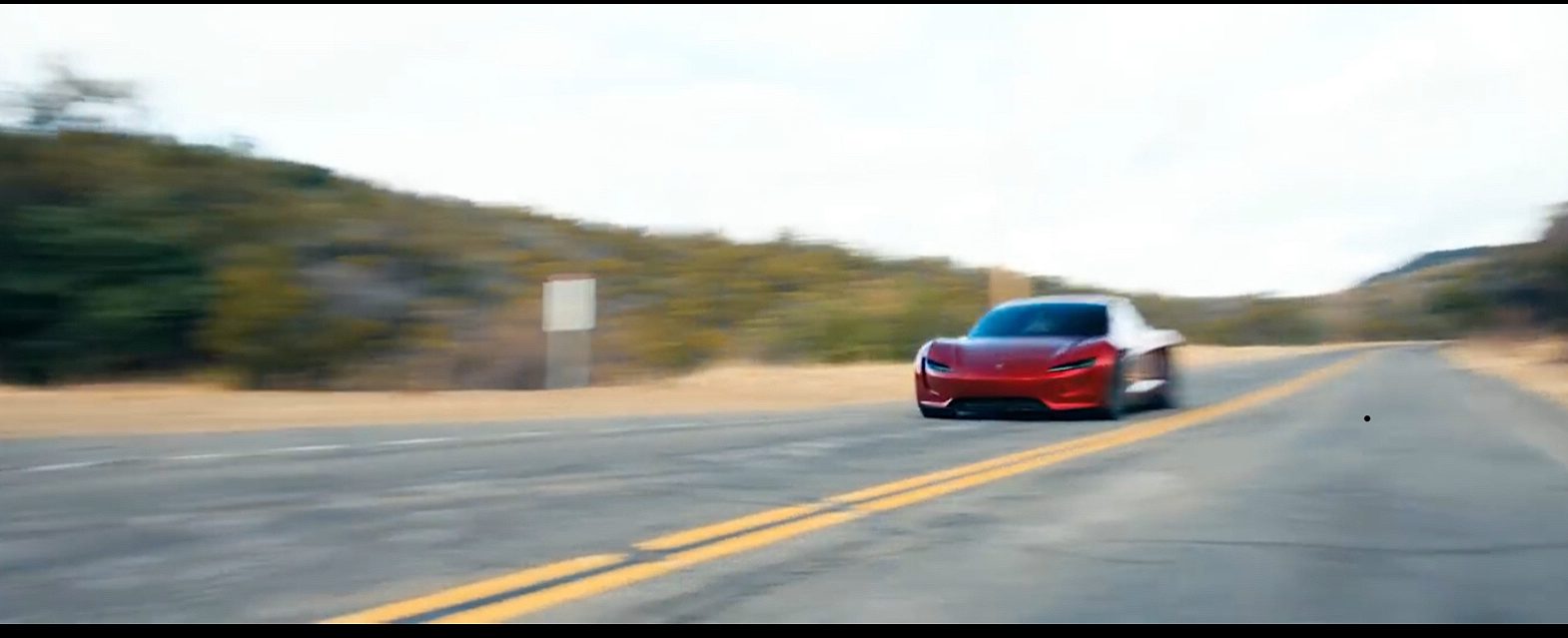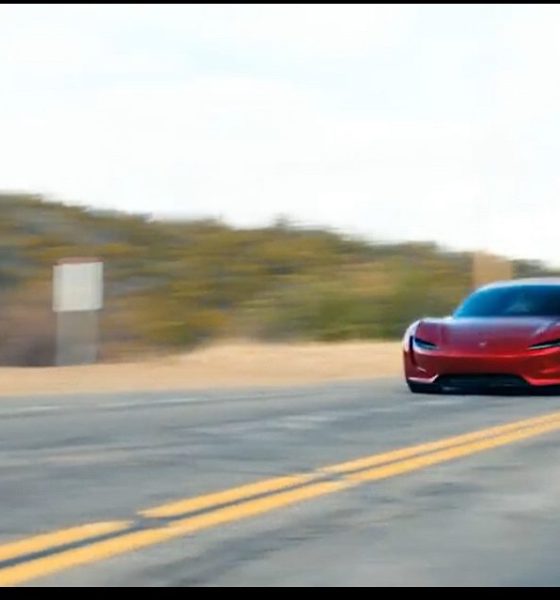

News
Tesla Roadster’s incredible 0-60 mph acceleration teased in new official video
Tesla has released a short video showcasing the next-generation Roaster’s blisteringly quick 0-60 mph acceleration of 1.9 seconds. “Zero to sixty faster than you can read this caption,” the all-electric car manufacturer posted on Twitter with video clip challenging viewers to do just that.
Once in production, next-gen Roadster owners will enjoy several performance advantages beyond acceleration including a 250+ mph top speed and 620 miles of battery range. All-wheel drive, 10,000 Nm of wheel torque, and a quarter mile time of 8.8 seconds also make the list of what’s included. Even with all those features packed in for track-level performance, the Roadster will still include seating for four. Perhaps even more amazingly, the next-gen Roadster will be offered at the relatively bang-for-the-buck base price of $200,000.
Zero to sixty faster than you can read this caption – https://t.co/ELg96rZfIq pic.twitter.com/4EFV9CvG8o
— Tesla (@Tesla) April 19, 2019
Tesla recently announced that all of its vehicles will include Autopilot as a standard feature, but the Roadster will have an additional “Augmented Mode” to enhance human driving ability.
“Definitely. Will also have Augmented Mode that will massively enhance human driving ability. Like a flying metal suit, but in car form …,” Tesla CEO Elon Musk said via Twitter in response to an Autopilot inquiry last year, drawing references and comparisons to Marvel’s Iron Man and Tony Stark. Musk has additionally teased that a SpaceX package will be available for purchase, enabling the Roadster to hover similar to the DeLorean of Back to the Future fame.
The Roadster was designed as a “hardcore smackdown” to gasoline cars, and with the current spec sheet, the all-electric supercar certainly looks like it will fulfill its purpose. The performance levels achievable by battery-electric vehicles aren’t without detractors, however. Chief technical executives at Ferrari and Lamborghini cited the lack of multiple full-power launch capability, battery placement, and lack of engine noise and deal-breakers for investment in an all-electric supercar earlier this year despite the existence of several fully electric supercars already setting new track records such as the NIO EP9.
Tesla isn’t planning on delivering next-gen Roadsters to customers until 2020, but the fan community hasn’t let that time frame stop them from dreaming about a Roadster-packed future. One graphics-savvy fan created and shared an impressive video likening the car to light due to the breakthrough it stands to represent in the auto industry. In another instance, an automotive render specialist published a clip depicting what it would be like to encounter the next-generation Tesla Roadster on the road in a drive-by fan video. Meanwhile, successful referral program participants are eagerly awaiting their Founders Series Roadsters won prior to Tesla’s reboot of the contest.

News
Tesla FSD fleet is nearing 7 billion total miles, including 2.5 billion city miles
As can be seen on Tesla’s official FSD webpage, vehicles equipped with the system have now navigated over 6.99 billion miles.

Tesla’s Full Self-Driving (Supervised) fleet is closing in on almost 7 billion total miles driven, as per data posted by the company on its official FSD webpage.
These figures hint at the massive scale of data fueling Tesla’s rapid FSD improvements, which have been quite notable as of late.
FSD mileage milestones
As can be seen on Tesla’s official FSD webpage, vehicles equipped with the system have now navigated over 6.99 billion miles. Tesla owner and avid FSD tester Whole Mars Catalog also shared a screenshot indicating that from the nearly 7 billion miles traveled by the FSD fleet, more than 2.5 billion miles were driven inside cities.
City miles are particularly valuable for complex urban scenarios like unprotected turns, pedestrian interactions, and traffic lights. This is also the difference-maker for FSD, as only complex solutions, such as Waymo’s self-driving taxis, operate similarly on inner-city streets. And even then, incidents such as the San Francisco blackouts have proven challenging for sensor-rich vehicles like Waymos.
Tesla’s data edge
Tesla has a number of advantages in the autonomous vehicle sector, one of which is the size of its fleet and the number of vehicles training FSD on real-world roads. Tesla’s nearly 7 billion FSD miles then allow the company to roll out updates that make its vehicles behave like they are being driven by experienced drivers, even if they are operating on their own.
So notable are Tesla’s improvements to FSD that NVIDIA Director of Robotics Jim Fan, after experiencing FSD v14, noted that the system is the first AI that passes what he described as a “Physical Turing Test.”
“Despite knowing exactly how robot learning works, I still find it magical watching the steering wheel turn by itself. First it feels surreal, next it becomes routine. Then, like the smartphone, taking it away actively hurts. This is how humanity gets rewired and glued to god-like technologies,” Fan wrote in a post on X.
News
Tesla starts showing how FSD will change lives in Europe
Local officials tested the system on narrow country roads and were impressed by FSD’s smooth, human-like driving, with some calling the service a game-changer for everyday life in areas that are far from urban centers.

Tesla has launched Europe’s first public shuttle service using Full Self-Driving (Supervised) in the rural Eifelkreis Bitburg-Prüm region of Germany, demonstrating how the technology can restore independence and mobility for people who struggle with limited transport options.
Local officials tested the system on narrow country roads and were impressed by FSD’s smooth, human-like driving, with some calling the service a game-changer for everyday life in areas that are far from urban centers.
Officials see real impact on rural residents
Arzfeld Mayor Johannes Kuhl and District Administrator Andreas Kruppert personally tested the Tesla shuttle service. This allowed them to see just how well FSD navigated winding lanes and rural roads confidently. Kruppert said, “Autonomous driving sounds like science fiction to many, but we simply see here that it works totally well in rural regions too.” Kuhl, for his part, also noted that FSD “feels like a very experienced driver.”
The pilot complements the area’s “Citizen Bus” program, which provides on-demand rides for elderly residents who can no longer drive themselves. Tesla Europe shared a video of a demonstration of the service, highlighting how FSD gives people their freedom back, even in places where public transport is not as prevalent.
What the Ministry for Economic Affairs and Transport says
Rhineland-Palatinate’s Minister Daniela Schmitt supported the project, praising the collaboration that made this “first of its kind in Europe” possible. As per the ministry, the rural rollout for the service shows FSD’s potential beyond major cities, and it delivers tangible benefits like grocery runs, doctor visits, and social connections for isolated residents.
“Reliable and flexible mobility is especially vital in rural areas. With the launch of a shuttle service using self-driving vehicles (FSD supervised) by Tesla in the Eifelkreis Bitburg-Prüm, an innovative pilot project is now getting underway that complements local community bus services. It is the first project of its kind in Europe.
“The result is a real gain for rural mobility: greater accessibility, more flexibility and tangible benefits for everyday life. A strong signal for innovation, cooperation and future-oriented mobility beyond urban centers,” the ministry wrote in a LinkedIn post.
News
Tesla China quietly posts Robotaxi-related job listing
Tesla China is currently seeking a Low Voltage Electrical Engineer to work on circuit board design for the company’s autonomous vehicles.

Tesla has posted a new job listing in Shanghai explicitly tied to its Robotaxi program, fueling speculation that the company is preparing to launch its dedicated autonomous ride-hailing service in China.
As noted in the listing, Tesla China is currently seeking a Low Voltage Electrical Engineer to work on circuit board design for the company’s autonomous vehicles.
Robotaxi-specific role
The listing, which was shared on social media platform X by industry watcher @tslaming, suggested that Tesla China is looking to fill the role urgently. The job listing itself specifically mentions that the person hired for the role will be working on the Low Voltage Hardware team, which would design the circuit boards that would serve as the nervous system of the Robotaxi.
Key tasks for the role, as indicated in the job listing, include collaboration with PCB layout, firmware, mechanical, program management, and validation teams, among other responsibilities. The role is based in Shanghai.
China Robotaxi launch
China represents a massive potential market for robotaxis, with its dense urban centers and supportive policies in select cities. Tesla has limited permission to roll out FSD in the country, though despite this, its vehicles have been hailed as among the best in the market when it comes to autonomous features. So far, at least, it appears that China supports Tesla’s FSD and Robotaxi rollout.
This was hinted at in November, when Tesla brought the Cybercab to the 8th China International Import Expo (CIIE) in Shanghai, marking the first time that the autonomous two-seater was brought to the Asia-Pacific region. The vehicle, despite not having a release date in China, received a significant amount of interest among the event’s attendees.








